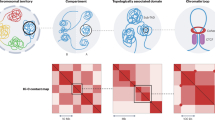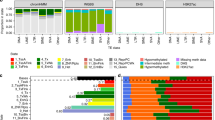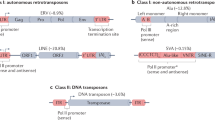Abstract
We present here a Sleeping Beauty–based transposition system that offers a simple and efficient way to investigate the regulatory architecture of mammalian chromosomes in vivo. With this system, we generated several hundred mice and embryos, each with a regulatory sensor inserted at a random genomic position. This large sampling of the genome revealed the widespread presence of long-range regulatory activities along chromosomes, forming overlapping blocks with distinct tissue-specific expression potentials. The presence of tissue-restricted regulatory activities around genes with widespread expression patterns challenges the gene-centric view of genome regulation and suggests that most genes are modulated in a tissue-specific manner. The local hopping property of Sleeping Beauty provides a dynamic approach to map these regulatory domains at high resolution and, combined with Cre-mediated recombination, allows for the determination of their functions by engineering mice with specific chromosomal rearrangements.
This is a preview of subscription content, access via your institution
Access options
Subscribe to this journal
Receive 12 print issues and online access
$209.00 per year
only $17.42 per issue
Buy this article
- Purchase on Springer Link
- Instant access to full article PDF
Prices may be subject to local taxes which are calculated during checkout






Similar content being viewed by others
References
ENCODE Project Consortium. et al. Identification and analysis of functional elements in 1% of the human genome by the ENCODE pilot project. Nature 447, 799–816 (2007).
Pennacchio, L.A. et al. In vivo enhancer analysis of human conserved non-coding sequences. Nature 444, 499–502 (2006).
Kleinjan, D.A. et al. Long-range downstream enhancers are essential for Pax6 expression. Dev. Biol. 299, 563–581 (2006).
Spitz, F., Gonzalez, F. & Duboule, D. A global control region defines a chromosomal regulatory landscape containing the HoxD cluster. Cell 113, 405–417 (2003).
Nobrega, M.A., Ovcharenko, I., Afzal, V. & Rubin, E.M. Scanning human gene deserts for long-range enhancers. Science 302, 413 (2003).
Sagai, T. et al. A cluster of three long-range enhancers directs regional Shh expression in the epithelial linings. Development 136, 1665–1674 (2009).
Libioulle, C. et al. Novel Crohn disease locus identified by genome-wide association maps to a gene desert on 5p13.1 and modulates expression of PTGER4. PLoS Genet. 3, e58 (2007).
Wang, K. et al. Common genetic variants on 5p14.1 associate with autism spectrum disorders. Nature 459, 528–533 (2009).
Visel, A., Rubin, E.M. & Pennacchio, L.A. Genomic views of distant-acting enhancers. Nature 461, 199–205 (2009).
Hallikas, O. et al. Genome-wide prediction of mammalian enhancers based on analysis of transcription-factor binding affinity. Cell 124, 47–59 (2006).
Visel, A. et al. ChIP-seq accurately predicts tissue-specific activity of enhancers. Nature 457, 854–858 (2009).
Heintzman, N.D. et al. Histone modifications at human enhancers reflect global cell-type-specific gene expression. Nature 459, 108–112 (2009).
Tuupanen, S. et al. The common colorectal cancer predisposition SNP rs6983267 at chromosome 8q24 confers potential to enhanced Wnt signaling. Nat. Genet. 41, 885–890 (2009).
Lettice, L.A. et al. A long-range Shh enhancer regulates expression in the developing limb and fin and is associated with preaxial polydactyly. Hum. Mol. Genet. 12, 1725–1735 (2003).
Jeong, Y. et al. Regulation of a remote Shh forebrain enhancer by the Six3 homeoprotein. Nat. Genet. 40, 1348–1353 (2008).
Benko, S. et al. Highly conserved non-coding elements on either side of SOX9 associated with Pierre Robin sequence. Nat. Genet. 41, 359–364 (2009).
D'haene, B. et al. Disease-causing 7.4 kb cis-regulatory deletion disrupting conserved non-coding sequences and their interaction with the FOXL2 promotor: implications for mutation screening. PLoS Genet. 5, e1000522 (2009).
Kurth, I. et al. Duplications of noncoding elements 5′ of SOX9 are associated with brachydactyly-anonychia. Nat. Genet. 41, 862–863 (2009).
Klopocki, E. et al. A microduplication of the long range SHH limb regulator (ZRS) is associated with triphalangeal thumb-polysyndactyly syndrome. J. Med. Genet. 45, 370–375 (2008).
Dathe, K. et al. Duplications involving a conserved regulatory element downstream of BMP2 are associated with brachydactyly type A2. Am. J. Hum. Genet. 84, 483–492 (2009).
Sun, M. et al. Triphalangeal thumb-polysyndactyly syndrome and syndactyly type IV are caused by genomic duplications involving the long-range, limb-specific SHH enhancer. J. Med. Genet. 45, 589–595 (2008).
Conrad, D.F. et al. Origins and functional impact of copy number variation in the human genome. Nature 464, 704–712 (2010).
Kidd, J.M. et al. Mapping and sequencing of structural variation from eight human genomes. Nature 453, 56–64 (2008).
Kokubu, C. et al. A transposon-based chromosomal engineering method to survey a large cis-regulatory landscape in mice. Nat. Genet. 41, 946–952 (2009).
Kondo, T. & Duboule, D. Breaking colinearity in the mouse HoxD complex. Cell 97, 407–417 (1999).
Nakatani, J. et al. Abnormal behavior in a chromosome-engineered mouse model for human 15q11–13 duplication seen in autism. Cell 137, 1235–1246 (2009).
Visel, A. et al. Targeted deletion of the 9p21 non-coding coronary artery disease risk interval in mice. Nature 464, 409–412 (2010).
Spitz, F., Herkenne, C., Morris, M.A. & Duboule, D. Inversion-induced disruption of the Hoxd cluster leads to the partition of regulatory landscapes. Nat. Genet. 37, 889–893 (2005).
Hérault, Y., Rassoulzadegan, M., Cuzin, F. & Duboule, D. Engineering chromosomes in mice through targeted meiotic recombination (TAMERE). Nat. Genet. 20, 381–384 (1998).
Wu, S., Ying, G., Wu, Q. & Capecchi, M.R. Toward simpler and faster genome-wide mutagenesis in mice. Nat. Genet. 39, 922–930 (2007).
Yee, S.P. & Rigby, P.W. The regulation of myogenin gene expression during the embryonic development of the mouse. Genes Dev. 7, 1277–1289 (1993).
Ivics, Z., Hackett, P.B., Plasterk, R.H. & Izsvak, Z. Molecular reconstruction of Sleeping Beauty, a Tc1-like transposon from fish, and its transposition in human cells. Cell 91, 501–510 (1997).
Luo, G., Ivics, Z., Izsvák, Z. & Bradley, A. Chromosomal transposition of a Tc1/mariner-like element in mouse embryonic stem cells. Proc. Natl. Acad. Sci. USA 95, 10769–10773 (1998).
Horie, K. et al. Characterization of Sleeping Beauty transposition and its application to genetic screening in mice. Mol. Cell. Biol. 23, 9189–9207 (2003).
Baus, J., Liu, L., Heggestad, A.D., Sanz, S. & Fletcher, B.S. Hyperactive transposase mutants of the Sleeping Beauty transposon. Mol. Ther. 12, 1148–1156 (2005).
Peschon, J.J., Behringer, R.R., Palmiter, R.D. & Brinster, R.L. Expression of mouse protamine 1 genes in transgenic mice. Ann. NY Acad. Sci. 564, 186–197 (1989).
Geurts, A.M. et al. Gene mutations and genomic rearrangements in the mouse as a result of transposon mobilization from chromosomal concatemers. PLoS Genet. 2, e156 (2006).
Reymond, A. et al. Human chromosome 21 gene expression atlas in the mouse. Nature 420, 582–586 (2002).
Wurst, W. et al. A large-scale gene-trap screen for insertional mutations in developmentally regulated genes in mice. Genetics 139, 889–899 (1995).
Pauler, F.M. et al. H3K27me3 forms BLOCs over silent genes and intergenic regions and specifies a histone banding pattern on a mouse autosomal chromosome. Genome Res. 19, 221–233 (2009).
Geurts, A.M. et al. Conditional gene expression in the mouse using a Sleeping Beauty gene-trap transposon. BMC Biotechnol. 6, 30 (2006).
Yae, K. et al. Sleeping Beauty transposon-based phenotypic analysis of mice: lack of Arpc3 results in defective trophoblast outgrowth. Mol. Cell. Biol. 26, 6185–6196 (2006).
Korn, R. et al. Enhancer trap integrations in mouse embryonic stem cells give rise to staining patterns in chimaeric embryos with a high frequency and detect endogenous genes. Mech. Dev. 39, 95–109 (1992).
Kikuta, H. et al. Genomic regulatory blocks encompass multiple neighboring genes and maintain conserved synteny in vertebrates. Genome Res. 17, 545–555 (2007).
Dimas, A.S. et al. Common regulatory variation impacts gene expression in a cell type–dependent manner. Science 325, 1246–1250 (2009).
Schmidt, D. et al. Five-vertebrate ChIP-seq reveals the evolutionary dynamics of transcription factor binding. Science 21, 1036–1040 (2010).
Wunderle, V.M., Critcher, R., Hastie, N., Goodfellow, P.N. & Schedl, A. Deletion of long-range regulatory elements upstream of SOX9 causes campomelic dysplasia. Proc. Natl. Acad. Sci. USA 95, 10649–10654 (1998).
Gordon, J., Bennett, A.R., Blackburn, C.C. & Manley, N.R. Gcm2 and Foxn1 mark early parathyroid- and thymus-specific domains in the developing third pharyngeal pouch. Mech. Dev. 103, 141–143 (2001).
Sumiyama, K. et al. Genomic structure and functional control of the Dlx3–7 bigene cluster. Proc. Natl. Acad. Sci. USA 99, 780–785 (2002).
Lefèvre, C. & Mann, J.R. RNA expression microarray analysis in mouse prospermatogonia: identification of candidate epigenetic modifiers. Dev. Dyn. 237, 1082–1089 (2008).
Acknowledgements
We thank all the members of the EMBL mouse and transgenic facilities for pronuclear injections of the transgenes and mouse husbandry, particularly C. Klasen, A. Schultz and S. Feller; B. Fletcher (University of Florida) for the Sleeping Beauty transposon and transposase plasmids; A. Ephrussi and A. Aulehla for discussions and comments on the manuscript; and A. Hermelin and EMBL information technology service for helping with the TRACER website. We are grateful to all the members of the Spitz lab and students of the EMBL PhD classes of 2008 and 2009 who contributed to embryo dissection and staining. O.S. is funded by a Louis-Jeantet Foundation PhD fellowship. This work was supported by funding from the European Molecular Biology Laboratory (to F.S.) and from the European Community's Seventh Framework Programme (FP7/ 2007-2013) under the grant agreement n°FP7-211868 (to L.E. and F.S.).
Author information
Authors and Affiliations
Contributions
F.S. conceived and designed the GROMIT strategy. S.R., O.S., V.V.U., C.H. and F.S. performed the experiments. O.S., D.D. and L.E. performed the statistical analyses. All authors discussed the results and contributed to the writing of the manuscript.
Corresponding author
Ethics declarations
Competing interests
The authors declare no competing financial interests.
Supplementary information
Supplementary Text and Figures
Supplementary Note, Supplementary Figures 1–9 and Supplementary Tables 1–3. (PDF 8467 kb)
Rights and permissions
About this article
Cite this article
Ruf, S., Symmons, O., Uslu, V. et al. Large-scale analysis of the regulatory architecture of the mouse genome with a transposon-associated sensor. Nat Genet 43, 379–386 (2011). https://doi.org/10.1038/ng.790
Received:
Accepted:
Published:
Issue Date:
DOI: https://doi.org/10.1038/ng.790
This article is cited by
-
Strand asymmetry influences mismatch resolution during single-strand annealing
Genome Biology (2022)
-
Murine allele and transgene symbols: ensuring unique, concise, and informative nomenclature
Mammalian Genome (2022)
-
Genetic dissection identifies Necdin as a driver gene in a mouse model of paternal 15q duplications
Nature Communications (2021)
-
CRISPR/Cas9: targeted genome editing for the treatment of hereditary hearing loss
Journal of Applied Genetics (2020)
-
Functional dissection of the Sox9–Kcnj2 locus identifies nonessential and instructive roles of TAD architecture
Nature Genetics (2019)



